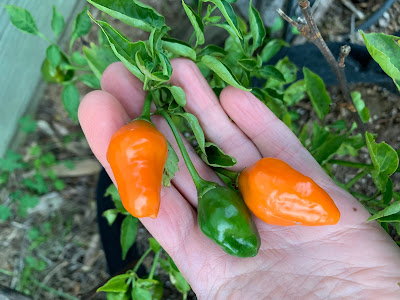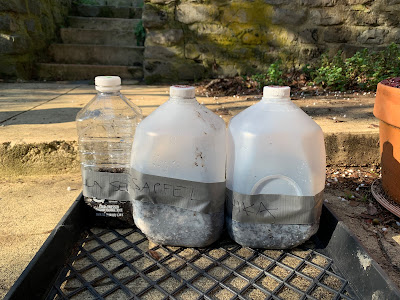Peppers in the City
People don't really think of San Francisco as a pepper growing paradise. Even in the sunny districts, it's not very hot for many days of the year. There are, however, some peppers that have grown really well for me and that prove the naysayers wrong. I love proving naysayers wrong.
Capsicum annuum: Chances are, when you think of a pepper, hot or sweet, you are thinking of a C. annuum. This is the species that contains red bell peppers and Aleppo peppers and jalapeños, serranos and New Mexico and pimentos.
From this species, last year, I planted out four Liebesapfel plants. This year, I'll plant even more. Though the fruit was slow to ripen, the first coming in early October, it consistently produced all fall into December. Scott felt the fruit was a little too crisp, but I loved the scalloped red peppers, and they made it into my daily lunch salads at work.
 |
| Liebesapfel in hand. |
 |
| Liebesapfel in the garden. |
I ordered my seed through Adaptive Seeds, but I saved a lot of seed last fall and am listing them currently through Seedsavers Exchange.
This year, I'm adding Gernika, a basque pepper, to my C. annum lineup.
Capsicum pubescens: C. pubescens live up to their name. They're hairy plants. They also have black seeds that are almost shocking if you aren't expecting them. While they're very hot, they also have thick flesh like a bell pepper, but the flesh isn't sweet, even when ripe. Instead, they have a rich, very spicy, very paprika-y flavor. In San Francisco, the plants are perennial bushes that I have written about before. I have a large fruited, deep red manzano and a smaller fruited, bright red rocoto. Both are plants that I purchased and are now well-established as bushes in my yard, and from which I've started seeds and shared the seedlings with others. In my yard, the fruit of this species begins ripening in the fall and continues through the winter.
This year, for the first time, I'm trying my hand at using some of the fruit in a fermented hot sauce. The fruit mash is fermenting right now, with garlic and salt, in a pickling crock. Will it be a wash, or will it mean our days of buying hot sauce are over?
 |
| A pile of rocotos. |
 |
| An experiment: fermenting rocoto and manzano mash. |
Capsicum baccatum: For flavor, this is my favorite species. They're the delicious, fruity and hot-sweet peppers that often have funny shapes like bishops' hats and starfish. When you hear a pepper referred to as an aji, it is usually referring to this species of pepper. In my current garden, a few of these have grown well for me, especially those with smaller fruit. Sometimes, they overwinter. I have a two-year-old Criolla Sella plant that produces spicy-citrusy yellow pinky fingers and another couple Aji Ecuador Orange plants that produce crisp, delicious top-shaped fruit that are very flavorful but not very hot. I hope to offer seed for both varieties in next year's Seedsavers Exchange listings.
 |
| Criolla Sella plus dog nose. |
 |
| Aji Ecuador Orange. |
Getting my peppers growing: I used to start my peppers on a heat mat under lights, but I've found a mini-greenhouse method works best for the cool-weather adapted peppers I grow here. I use old milk and juice containers, punch some holes in the bottom with my trusty old awl, and cut them open along three sides to make fliptop greenhouses. I fill them with soil, place seeds on the soil surface, gently add another loose, very shallow layer of soil, water it all in with a gentle spray, then duct tape it shut and label it. I keep the lids on until the days start warming up, at which time I remove them to prevent overheating the seedlings. I keep peering in through the lid until I see true leaves; when I see those true leaves, I open up the cartons and pot up the seedlings. After putting them up, I use a very large tupperware placed upside down as a cold frame to help them along for a couple weeks until they're big enough and the weather is warm enough for them to harden off and go into the ground. I like this system better than grow lights, a heat lamp, and a fan: I end up with healthier plants and I don't have to use energy other than the sun.
 |
| Holes punched, three walls cut. |
 |
| A sunny spot for my peppers to get started. |
Comments
I am trying to get into patio gardening this year.
I live outer Sunset.
I am trying four varieties of hot pepper Serrano, Fresno, Jalapeno and Cajun.